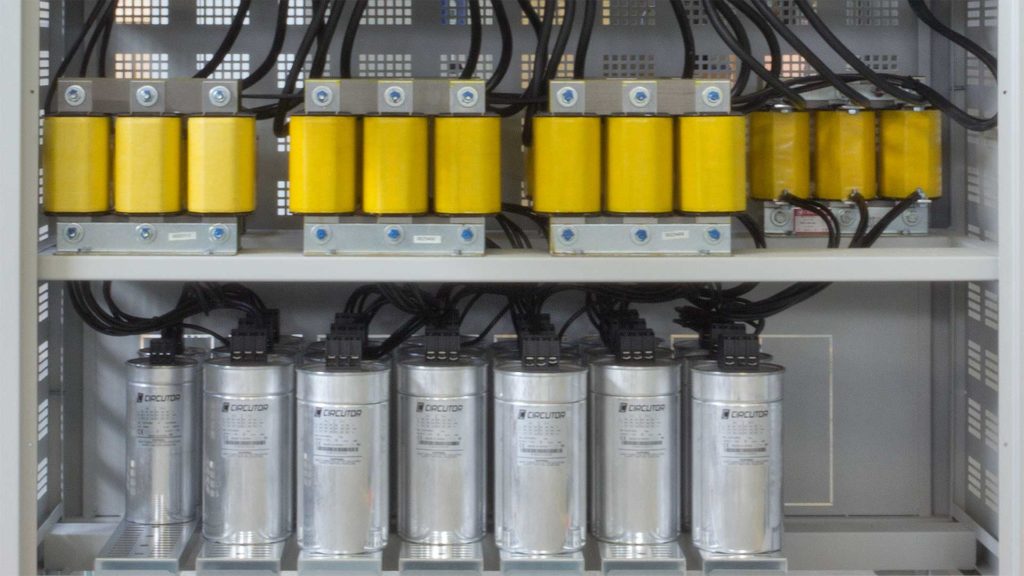
Without a doubt, voltage and current harmonics have turned into a parameter that absolutely has to be managed and controlled, especially to prevent potential problems that, as we will see later, involve the presence of these harmonics in our electrical network.
Managing and controlling electrical harmonics is essential to keep various problems from arising in an electrical network.

What is a harmonic?
First, let us define the term "harmonic".
We will do so by travelling to the early 19th century, when the mathematician Jean Baptiste Fourier realized that any periodic waveform can be broken down into a sum of simple sinusoids of different frequencies and amplitudes, which are called harmonics.
But let's look at an example that will no doubt let us understand the concept better:
Suppose that the wave shown in Fig. 1 corresponds to "one cycle" of current in a 50 Hz network. That is, it repeats itself 50 times a second and has a 20-millisecond duration. If it were a 60 Hz network, it would last 16.6 ms. We will call this wave a "fundamental".
And let's superimpose another wave on top with a smaller amplitude but at 250 Hz; that is, 5 times the frequency. This wave, shown in Fig. 2, would correspond to the 5th harmonic, and the resulting wave would be that of Fig. 3.
And to finish, let's superimpose atop these two one at 350 Hz, 7 times higher frequency than the fundamental, the 7th harmonic, shown in Fig. 4. The final resulting wave would be the one we see in Fig. 5, which we informally refer to as the "McDonalds M".
This is the wave that we would normally measure, for example, at the input to most three-phase variable-speed drives, which are essential loads these days in industrial installations.
WAVE FORMS
Fig. 1
Fig. 2
Fig. 3
Fig. 4
Fig. 5
In short, the current wave generated by a variable-speed drive can thus be simplified and very closely approximated by the fundamental wave of 50 or 60 Hz, and basically the 5th and 7th harmonics.
We will therefore divide the electrical loads between those that consume a purely fundamental current, which we will call linear loads, such as induction motors, or purely resistive loads; and those that consume a fundamental plus other harmonic currents, which we know to be non-linear or distorting loads. These include variable speed or frequency drives, one-phase electronic equipment and LED lights; in summary, all those loads where at least one stage of their operation involves converting an alternating current to continuous current.

To analyze the harmonic content of the electrical network, we will use the frequency decomposition, or what is known as its spectrum; that is, the amplitude, or value, of each harmonic order. Fig.6
Thus, for networks with a predominance of three-phase loads, the most important harmonics would be 5, 7, 11 and 13, in decreasing order of magnitude. And, in the case of 4-wire networks with a significant presence of single-phase loads between a phase and neutral, the 3rd, 9th and 15th harmonics would also be present, in addition to the above, with the 3rd harmonic generally being the most significant one in this case.
And the parameter that we normally use to evaluate harmonic levels in a network is the total harmonic distortion, THD (U) for voltage and THD (I) for current. THD represents the percentage of harmonic voltage or current, calculated from the RMS value, or root mean square sum of the values of each frequency, with respect to the value of the fundamental. The THD will let us, as we will see, determine the severity of the harmonic distortion in our network and whether we need to apply corrective measures.

One important aspect to consider is that, as we have determined, it is the non-linear or distorting loads that generate current harmonics, and the fact that these current harmonics flow through the distribution cables causes voltage drops at the different harmonic frequencies. This entails the appearance of harmonic voltages, meaning they distort the voltage, thus increasing the value of the THD (U). Therefore, THD (I) and THD (U) will always be values that have to be analyzed together whenever the need arises to solve some type of problem associated with electrical harmonics in our network.
Another important feature of electrical harmonics is the fact that they exhibit different phase sequences. These can be direct, reverse or homopolar, also known as zero sequence.
Fig. 7
Direct sequence (positive)
Reverse sequence (negative)
Homopolar sequence (zero)
The source of problems in electricity networks
For practical purposes, the latter, which correspond to triple harmonics, are the ones that pose the biggest problem in electricity networks because, since they are in phase, they add to one another. Thus, in 4-wire networks, three phases and one neutral, with a significantly high number of electronic single-phase loads (computers and similar devices), since they do not cancel each other out, they add up in the neutral conductor.
Therefore, if we assume a network with 50 A of 3rd order harmonic current for each phase, in the neutral conductor we will have 150 A of 3rd order harmonic current.
This entails a risk of overload in this neutral conductor, in terms of triggering both overcurrent and switching safeguards in the neutral wire. This would lead to the most adverse situation, due to the significant imbalance in the supply voltages of the loads that would result, which could cause serious damage to any device connected at the time due to overvoltage.
Problems also arise frequently involving the power transformers that supply the installation. If these transformers were to supply not just the fundamental current associated with the active power, but also non-productive harmonic currents (meaning they serve no useful purpose), the losses could be so high that they would cause the quality of the voltage supplied to be poor, with high levels of THD (U). This would affect the operation of the loads being supplied. In the most extreme case, the temperature in the transformer could increase to the point that it would destroy this device.
Another essential aspect is the impact that the presence of electrical harmonics can have on residual current protection against leakage currents. It is essential that suitable earth leakage relays be used to provide adequate protection in these networks. In this regard, the use of type-B RCCBs is not just essential, but required for all those receivers that incorporate AC/DC conversion into their operation (such as variable-speed drives, UPS, rectifiers or chargers for electric vehicles).
As for the presence of high levels of harmonic distortion in network voltage, this can cause problems to appear in "sensitive" electronic devices. In this case, the poor quality of the supply voltage can cause them to malfunction, leading to resets, interference, calculation errors, etc.
Finally, the most common and well-known issue is the problem between installing a capacitor bank to compensate for inductive reactive energy and the existence of electrical harmonics in the network.
Explanation of this case
Let us first consider the impedance curve of a capacitor, which we can call "resistance". As we can see in Fig. 8, the higher the frequency, the lower the impedance. And we already know that harmonics have a higher frequency than the fundamental frequency of the network. A capacitor thus has less resistance to these harmonic frequencies. As a result, it becomes a "path of low impedance" for these currents. In other words, it tends to absorb them, such that in networks with harmonics, capacitors always overload at a certain level. This causes them to degrade in the short term.
Fig. 8
Fig. 9
However, this overload is not the biggest problem that can arise. Instead, there is a chance that resonance will appear, which involves amplifying the pre-existing harmonic currents in the network before the connection to the capacitor bank.
We then have to consider the parameter known as the resonance frequency of the system (Fig. 9), which relates the short-circuit power at the point where the capacitor bank is connected to the network with the power in kvarC of the bank itself. This value indicates the order of the harmonic, i.e., 5th, 7th, 11th, etc., that could be amplified when the capacitors are connected to the network.

The example in Fig. 10 shows a clear resonance in the 5th harmonic. We simply have to count the 5 "peaks" that appear in one cycle.
The solution to prevent this resonance phenomenon relies on installing capacitor banks with rejection or untuned filters. These banks feature a reactance in series with each capacitor or group of capacitors in each step, shown in Fig. 11 in yellow. This tunes the reactance-capacitor group to a frequency below that of the first relevant harmonic in the network.

Fig. 11, Capacitor banks with rejection or untuned filters
As noted, the first relevant harmonic in the network is, in the vast majority of cases, the third or the fifth. And the usual resonance frequencies are those shown in Fig. 12 (values indicated at 50 Hz/60 Hz).
Fig.12
| P% | fr | Harmonic Rejected |
| 7% | 189 / 277 Hz | h>5º, f>250 / 300 Hz |
| 14% | 134 / 160 Hz | h>3º, f>150 / 180 Hz |
| 8,7% | 170 / 203 Hz | h>5º, f>250 / 300 Hz* |
| * Reinforced filter: THD(U) > 5% | ||
Systems that guarantee 100% reactive energy compensation that is completely immune to the presence of harmonics in the network are static var generators, specifically the CIRCUTOR SVGm range (Fig. 13). These reactive energy generators, which can compensate for both inductive and capacitive power, rely on power electronics and offer the most technologically advanced solution for correcting cosine phi.

There are options for passively filtering out harmonic currents, the simplest of which are line or choke reactors (Fig. 14). These are installed at the input of variable-speed drives or similar loads and can provide some degree of THD (I) reduction, usually from initial values of around 40% to final values of 25%.

In any case, the most efficient way to reduce harmonic current levels, and thus also harmonic voltages, in electrical networks is to use active harmonic filters, like the ones in the CIRCUTOR AFQm range.
An AFQm active filter is, in fact, a harmonic current generator that, by using the most advanced power electronics and the most innovative control systems, is able to inject harmonic currents that are out of phase with the harmonics in the network, thus cancelling them out.

Notable among its many advantages over passive filtering systems is its accuracy. It is able to inject the exact harmonic current needed to offset each harmonic current in the network, regardless of the load variability.
Equally notable is its versatility, as it offers the capacity not only to filter out harmonic currents, but also to provide reactive power compensation.
Thanks to its modularity, the line-up of AFQm active filters provides a range of current injection capacities that spans every scenario for any electrical installation, whether industrial or service. It also works at operating voltages from 208 VAC to 690 VAC.

2 Solutions: Wall type and Rack type
For networks of 50/60 Hz ±5
| Wall type | Rack type (cabinet) | |
| 30 A | 100 A | 200 A |
| 60 A | 300 A | 400 A |
| 100 A | ||


WRITTEN BY CIRCUTOR